Part B – Steering and sailing rules
Section I – Conduct of vessels in any condition of visibility
Rule 4
Application
Rules in this section apply in any condition of visibility.
Rule 5
Look-out
Every vessel shall at all times maintain a proper look-out by sight and hearing as well as by all available means appropriate in the prevailing circumstances and conditions so as to make a full appraisal of the situation and of the risk of collision.
Explanations from the Centre for Lifelong Learning in the Westfjords:
The rule about maintain a proper look-out also applies to small vessels. This rule applies even though only one person is on board. It is important to look in all directions and use both sight and hearing (listen for sound signals) to evaluate circumstances and to prevent collision. If radar is onboard the vessel it should be used when circumstances demands so. Keep in mind that a mullion between the windows on the wheelhouse can block the view and form a blind spot. If a vessel were in that direction (in the blind spot) and the bearing did not change, there would be a considerable risk of collision. It is also important to keep the windows as clean as possible.
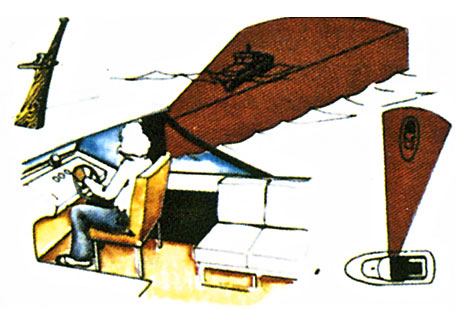
Rule 6
Safe speed
Every vessel shall at all times proceed at a safe speed so that she can take proper and effective action to avoid collision and be stopped within a distance appropriate to the prevailing circumstances and conditions.
In determining a safe speed the following factors shall be among those taken into account:
a) By all vessels:
(i) the state of visibility;
(ii) the traffic density including concentrations of fishing vessels or any other vessels;
(iii) the manoeuvrability of the vessel with special reference to stopping distance and turning ability in the prevailing conditions;
(iv) at night the presence of background light such as from shore lights or from back scatter of her own lights;
(v) the state of wind, sea and current, and the proximity of navigational hazards;
(vi) the draught in relation to the available depth of water.
b) Additionally by vessels with operational radar:
(i) the characteristics, efficiency and limitations of the radar equipment;
(ii) any constraints imposed by the radar range scale in use;
(iii) the effect on radar detection of the sea state, weather and other sources of interference;
(iv) the possibility that small vessels, ice and other floating objects may not be detected by radar at an adequate range;
(v) the number, location and movement of vessels detected by radar;
(vi) the more exact assessment of the visibility that may be possible when radar is used to determine the range of vessels or other objects in the vicinity.
Explanations from the Centre for Lifelong Learning in the Westfjords:
At night there tends to be a shadow up the shore which confuses the distance perception.

Rule 7
Risk of collision
a) Every vessel shall use all available means appropriate to the prevailing circumstances and conditions to determine if risk of collision exists. If there is any doubt such risk shall be deemed to exist.
b) Proper use shall be made of radar equipment if fitted and operational including long-range scanning to obtain early warning of risk of collision and radar plotting or equivalent systematic observation of detected objects.
c) Assumptions shall not be made on the basis of scanty information especially scanty radar information.
d) In determining if risk of collision exists the following considerations shall be among those taken into account:
i) such risk shall be deemed to exist if the compass bearing of an approaching vessel does not appreciably change;
ii) such risk may sometimes exist even when an appreciable bearing change is evident, particularly when approaching a very large vessel or a tow or when approaching a vessel at close range.
Explanations from the Centre for Lifelong Learning in the Westfjords:
To make sure that the vessel’s bearing does not change, it is important to maintain the same course while the vessel is bearing.
A convenient method on board a small vessel to make sure whether the bearing changes, is to observe whether the vessel’s location changes while comparing it to a fixed point on board on our vessel. This fixed point can, for example, be a mullion in the wheelhouse window.
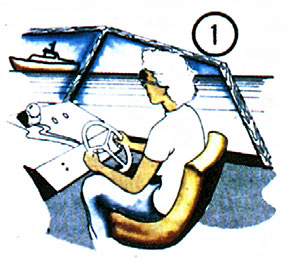
If repeated bearings show that the boat or the vessel moves, considerably, in front of or behind the centreline there is no danger of collision.
Rule 8
Action to avoid collision
a) Any action to avoid collision shall be taken in accordance with the Rules of this Part and shall, if the circumstances of the case admit, be positive, made in ample time and with due regard to the observance of good seamanship.
b) Any alteration of course and/or speed to avoid collision shall, if the circumstances of the case admit, be large enough to be readily apparent to another vessel observing visually or by radar; a succession of small alterations of course and/or speed should be avoided.
c) If there is sufficient sea-room, alteration of course alone may be the most effective action to avoid a close-quarters situation provided that it is made in good time, is substantial and does not result in another close-quarters situation.
d) Action taken to avoid collision with another vessel shall be such as to result in passing at a safe distance. The effectiveness of the action shall be carefully checked until the other vessel is finally past and clear.
e) If necessary to avoid collision or allow more time to assess the situation, a vessel shall slacken her speed or take all way off by stopping or reversing her means of propulsion.
(f)
(i) A vessel which, by any of these Rules, is required not to impede the passage or safe passage of another vessel shall, when required by the circumstances of the case, take early action to allow sufficient sea-room for the safe passage of the other vessel.
(ii) A vessel required not to impede the passage or safe passage of another vessel is not relieved of this obligation if approaching the other vessel so as to involve risk of collision and shall, when taking action, have full regard to the action which may be required by the Rules of this Part.
(iii) A vessel the passage of which is not to be impeded remains fully obliged to comply with the Rules of this Part when the two vessels are approaching one another so as to involve risk of collision.
Explanations from the Centre for Lifelong Learning in the Westfjords:
The Regulations clearly stipulate that vessels can not impede other vessels which due to their occupation are passing through the sailing area; these vessels can for example be ferries on scheduled routes, speedboats which transport passengers or larger vessels in coastal sailings.
In addition, it is better that vessels take action in ample time and alters their course and/or speed significantly when they keep out of the way. Otherwise operators of larger vessels cannot be sure that the other vessel will keep out of the way, as she should do according to the Regulations, and will therefore perhaps resort to unnecessary actions for safety reasons.
Rule 9
Narrow channels
a) A vessel proceeding along the course of a narrow channel or fairway shall keep as near to the outer limit of the channel or fairway which lies on her starboard side as is safe and practicable.
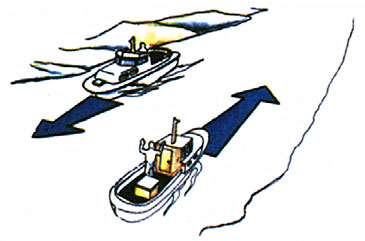
b) A vessel of less than 20 metres in length or a sailing vessel shall not impede the passage of a vessel which can safely navigate only within a narrow channel or fairway.
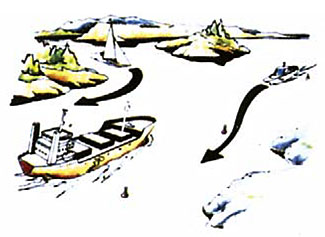
c) A vessel engaged in fishing shall not impede the passage of any other vessel navigating within a narrow channel or fairway.
d) A vessel shall not cross a narrow channel or fairway if such crossing impedes the passage of a vessel which can safely navigate only within such channel or fairway. The latter vessel may use the sound signal prescribed in Rule 34(d) if in doubt as to the intention of the crossing vessel.
e)
(i) In a narrow channel or fairway when overtaking can take place only if the vessel to be overtaken has to take action to permit safe passing, the vessel intending to overtake shall indicate her intention by sounding the appropriate signal prescribed in Rule 34(c)(i). The vessel to be overtaken shall, if in agreement, sound the appropriate signal prescribed in Rule 34(c)(ii) and take steps to permit safe passing. If in doubt she may sound the signals prescribed in Rule 34(d).
(ii) This Rule does not relieve the overtaking vessel of her obligation under Rule 13.
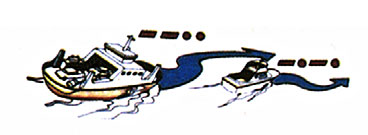
f) A vessel nearing a bend or an area of a narrow channel or fairway where other vessels may be obscured by an intervening obstruction shall navigate with particular alertness and caution and shall sound the appropriate signal prescribed in Rule 34(e).
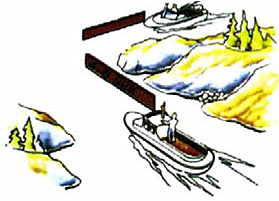
g) Any vessel shall, if the circumstances of the case admit, avoid anchoring in a narrow channel.
Explanations from the Centre for Lifelong Learning in the Westfjords:
This rule applies to narrow channels, for instance when sailing through entrance channels to harbours or narrow straits.
Small vessels can in some instances sailed outside customary channels (outside of or within the leading marks), or sailed in a red or a green light sector, on safe depth, in order to avoid collision with larger vessels. When we alter our course at a buoy or on a narrow channel, turn as far to the starboard as we can, that is we either take a sharp turn to the starboard or a wide turn to the larboard. In such circumstances we cannot count on that the other vessel keeps out of the way according to Rule 15, even though we approached the vessel on the starboard side before we started the turn.
Rule 15 assumes that circumstances allow unchanged courses.
Rule 10
Traffic separation schemes
a) This Rule applies to traffic separation schemes adopted by the Organization and does not relieve any vessel of her obligations under any other of these Rules.
b) A vessel using a traffic separation scheme shall:
(i) proceed in the appropriate traffic lane in the general direction of traffic flow for that lane;
(ii) so far as practicable keep clear of a traffic separation line or separation zone;
(iii) normally join or leave a traffic lane at the termination of the lane, but when joining or leaving from either side shall do so at as small an angle to the general direction of traffic flow as practicable.
c) A vessel shall so far as practicable avoid crossing traffic lanes, but if obliged to do so shall cross on a heading as nearly as practicable at right angles to the general direction of traffic flow.
d)
(i) A vessel shall not use an inshore traffic zone when she can safely use the appropriate traffic lane within the adjacent traffic separation scheme. However, vessels of less than 20 metres in length, sailing vessels and vessels engaged in fishing may use the inshore traffic zone.
(ii) Despite subparagraph (i), a vessel may use an inshore traffic zone when en route to or from a port, offshore installation or structure, pilot station or any other place situated within the inshore traffic zone, or to avoid immediate danger.
e) A vessel other than a crossing vessel or a vessel joining or leaving a lane shall not normally enter a separation zone or cross a separation line except:
(i) in cases of emergency to avoid immediate danger;
(ii) to engage in fishing within a separation zone.
f) A vessel navigating in areas near the terminations of traffic separation schemes shall do so with particular caution.
g) A vessel shall so far as practicable avoid anchoring in a traffic separation scheme or in areas near its terminations.
h) A vessel not using a traffic separation scheme shall avoid it by as wide a margin as is practicable.
i) A vessel engaged in fishing shall not impede the passage of any vessel following a traffic lane.
j) A vessel of less than 20 metres in length or a sailing vessel shall not impede the safe passage of a power-driven vessel following a traffic lane.
k) A vessel restricted in her ability to manoeuvre when engaged in an operation for the maintenance of safety of navigation in a traffic separation scheme is exempted from complying with this Rule to the extent necessary to carry out the operation.
l) A vessel restricted in her ability to manoeuvre when engaged in an operation for the laying, servicing or picking up of a submarine cable, within a traffic separation scheme, is exempted from complying with this Rule to the extent necessary to carry out the operation.
Explanations from the Centre for Lifelong Learning in the Westfjords:
Traffic separation schemes can be compared to two-lane expressway, namely one lane in each direction, with a line or area between the lanes which separates the navigation courses.
These regulations also apply within traffic separation schemes. Traffic separation schemes are marked on the chart and there are also special signs which show the navigation course that should be followed.
Section II – Conduct of vessels in sight of one another
Rule 11
Application
Rules in this Section apply to vessels in sight of one another.
Rule 12
Sailing vessels
a) When two sailing vessels are approaching one another, so as to involve risk of collision, one of them shall keep out of the way of the other as follows:
i) when each has the wind on a different side, the vessel which has the wind on the port side shall keep out of the way of the other;

ii) when both have the wind on the same side, the vessel which is to windward shall keep out of the way of the vessel which is to leeward;

iii) if a vessel with the wind on the port side sees a vessel to windward and cannot determine with certainty whether the other vessel has the wind on the port or on the starboard side, she shall keep out of the way of the other.
b) For the purposes of this Rule the windward side shall be deemed to be the side opposite to that on which the mainsail is carried or, in the case of a square-rigged vessel, the side opposite to that on which the largest fore-and-aft sail is carried.

Explanations from the Centre for Lifelong Learning in the Westfjords:
This rule applies to two sailing vessels that are approaching each other. What determines which of the two vessels should keep out of the way are the wind direction and the layout of the sails. Windward is the side which the wind blows on. Leeward is the opposite side. When it is dark, and we can only see the sidelights, we have to be extremely careful and observant, because it can be difficult to determine which side the sails are on. Keep in mind that the provisions in Rule 13 precede this rule, regardless of the wind direction.
Rule 13
Overtaking
a) Notwithstanding anything contained in the Rules of Part B, Sections I and II, any vessel overtaking any other shall keep out of the way of the vessel being overtaken.

b) A vessel shall be deemed to be overtaking when coming up with another vessel from a direction more than 22.5 degrees abaft her beam, that is, in such a position with reference to the vessel she is overtaking that at night she would be able to see only the sternlight of that vessel but neither of her sidelights.
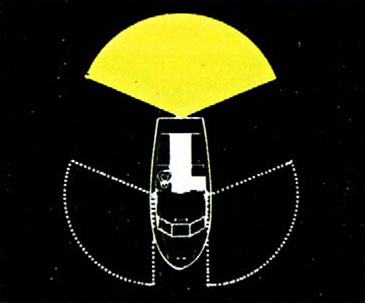
c) When a vessel is in any doubt as to whether she is overtaking another, she shall assume that this is the case and act accordingly.
d) Any subsequent alteration of the bearing between the two vessels shall not make the overtaking vessel a crossing vessel within the meaning of these Rules or relieve her of the duty of keeping clear of the overtaken vessel until she is finally past and clear.
Explanations from the Centre for Lifelong Learning in the Westfjords:
According to Rule 13 a vessel which is overtaking another vessel should keep out of the way. This rule also applies to a sailing vessel that overtakes a power-driven vessel. The sailing vessel must keep out of the way. If we overtake another vessel on a narrow channel, we must overtake the vessel on the side which is further away from the shore or longer away from other traffic. If possible, we should preferably overtake the vessel on the portside. We have to give sound signal in accordance to Rule 34 (c).
Do not overtake another vessel if the view is limited and it is not possible to see the traffic which comes in the opposite direction. We also have to keep in mind that the vessel we are overtaking could reduce speed or stop. Always keep a safe distance when overtaking another vessel. If sailed too near the stern of large vessels, the suction from the propeller can suck in a small boat and caused dangerous situation.

A vessel of less than 20 metres in length which is being overtaken by a large vessel on a narrow channel or fairway has to keep out of the way (according to Rule 9 (b)).
In boat races (both for sail- and power-driven vessels) special rules often apply between contestants.
Rule 14
Head-on situation
a) When two power-driven vessels are meeting on reciprocal or nearly reciprocal courses so as to involve risk of collision each shall alter her course to starboard so that each shall pass on the port side of the other.
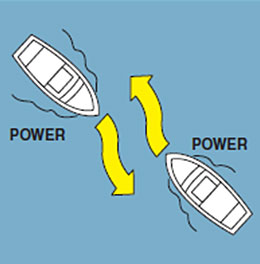
b) Such a situation shall be deemed to exist when a vessel sees the other ahead or nearly ahead and by night she could see the masthead lights of the other in a line or nearly in a line and/or both sidelights and by day she observes the corresponding aspect of the other vessel.

c) When a vessel is in any doubt as to whether such a situation exists she shall assume that it does exist and act accordingly.
Explanations from the Centre for Lifelong Learning in the Westfjords:
This Rule only applies when two motor-driven vessel head straight, or nearly straight, at each other. Both vessels should alter their course to starboard so that each shall pass on the port side of the other. On smaller vessels we can see that they are on reciprocal courses if their prows are pointed at each other. The phrase “almost reciprocal courses” means that the vessel’s prow, which is heading towards your vessel, is less than 5-6° to the side of the prow of your own vessel. If the prow of the vessel, which is heading towards your vessel, is more than 5-6° to the side of the prow of your own vessel Rule 15 applies.
At night both the sidelights on the other vessel can be seen simultaneously if the screens on the sidelights are rightly installed. On a vessel with combined lantern it can be harder. If there is any doubt whether the vessels are meeting on reciprocal courses turn to starboard in time, so that the red sidelight can be clearly seen from the vessel which is sailing towards you. That is how we follow this rule.

Rule 15
Crossing situation
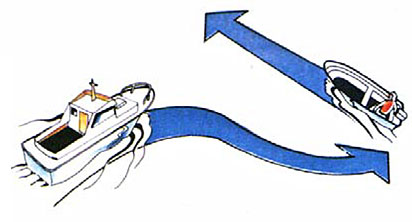
When two power-driven vessels are crossing so as to involve risk of collision, the vessel which has the other on her own starboard side shall keep out of the way and shall, if the circumstances of the case admit, avoid crossing ahead of the other vessel.
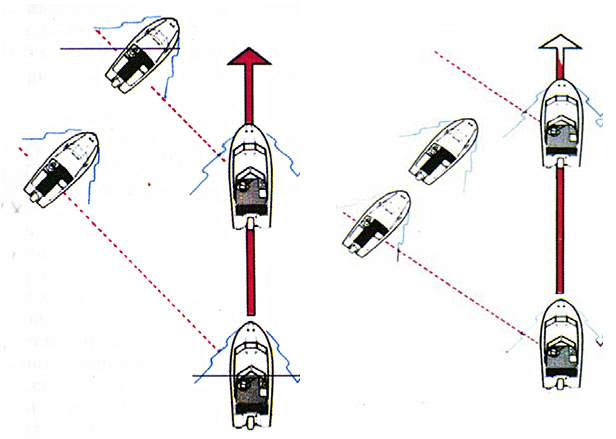
Explanations from the Centre for Lifelong Learning in the Westfjords:
When we keep out of the way we should avoid going in front of the other vessel.
We should preferably turn to starboard and go behind the other vessel; another option is to reduce speed. We can stop and sail backwards if necessary in order to let the other vessel pass. Nevertheless it is best to change the course considerably and in time if possible, if circumstances and traffic allows.
We can expect to have to keep out of the way according Rule 15 when we have a vessel on our starboard side between 5-6° and to 22.5° and the bearing changes almost nothing.
If the bearing changes, the vessel will either go in front of us or behind us.
Rule 16
Action by give- way vessel
Every vessel which is directed to keep out of the way of another vessel shall, so far as possible, take early and substantial action to keep well clear.
Rule 17
Action by stand-on vessel
a)
i) Where one of two vessels is to keep out of the way the other shall keep her course and speed;
ii) The latter vessel may however take action to avoid collision by her manoeuvre alone, as soon as it becomes apparent to her that the vessel required to keep out of the way is not taking appropriate action in compliance with these Rules.
b) When, from any cause, the vessel required to keep her course and speed finds herself so close that collision cannot be avoided by the action of the give-way vessel alone, she shall take such action as will best aid to avoid collision.
c) A power-driven vessel which takes action in a crossing situation in accordance with subparagraph (a)(ii) of this Rule to avoid collision with another power-driven vessel shall, if the circumstances of the case admit, not alter course to port for a vessel on her own port side.
d) This Rule does not relieve the give-way vessel of her obligation to keep out of the way.
Explanations from the Centre for Lifelong Learning in the Westfjords:
If we are too near a vessel which should keep out of the way of us and no signs can be seen that she is going to keep out of the way, we have to take action to avoid collision.
Example:
We are on vessel A and we see that vessel B is approaching in a crossing situation. We feel that vessel B keeps out of the way too late and we indicate it with sound signals according to Rule 34 (d). It has no influence on vessel B so we have to keep out the way in order to avoid collision. Therefore we give one short sound signal with our whistle, in accordance with Rule 34 (a), so the operator of vessel B knows that we are going to turn to the starboard.
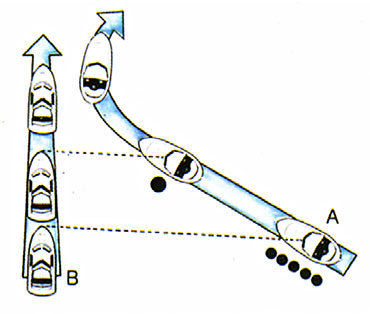
However, if vessel A is a sailing vessel, which according to this Rule has to maintain her course and speed, we have to take action and come about when the distance between the two vessels is sufficient so that we can take the circle and the vessel which should keep out of the way can then act accordingly.
The vessel that should keep out of the way should also keep in mind, and be prepared for, that the sailing vessel cannot always maintain her course and speed due to unexpected change in the weather.
Rule 18
Responsibilities between vessels
Except where Rules 9, 10 and 13 otherwise require:
a) A power-driven vessel underway shall keep out of the way of:
(i) a vessel not under command;
(ii) a vessel restricted in her ability to manoeuvre;
(iii) a vessel engaged in fishing;
(iv) a sailing vessel.
b) A sailing vessel underway shall keep out of the way of:
(i) a vessel not under command;
(ii) a vessel restricted in her ability to manoeuvre;
(iii) a vessel engaged in fishing.
c) A vessel engaged in fishing when underway shall, so far as possible, keep out of the way of:
(i) a vessel not under command;
(ii) a vessel restricted in her ability to manoeuvre.
d)
(i) Any vessel other than a vessel not under command or a vessel restricted in her ability to manoeuvre shall, if the circumstances of the case admit, avoid impeding the safe passage of a vessel constrained by her draught, exhibiting the signals in Rule 28.
(ii) A vessel constrained by her draught shall navigate with particular caution having full regard to her special condition.
e) A seaplane on the water shall, in general, keep well clear of all vessels and avoid impeding their navigation. In circumstances, however, where risk of collision exists, she shall comply with the Rules of this part.
f)
(i) A WIG craft shall, when taking off, landing and in flight near the surface, keep well clear of all other vessels and avoid impeding their navigation.
(ii) A WIG craft operating on the water surface shall comply with the Rules of this Part as if it were a power-driven vessel.
Explanations from the Centre for Lifelong Learning in the Westfjords:
This Rule, which is in four paragraphs (a, b, c and d), tells us what vessels should keep out of the way of whom. Exceptions from this Rule can be found in Rules 9, 10 and 13.
Example: Rule 18 (a i) stipulates that a power-driven vessel should keep out of the way of a sailing vessel. Rule 13, however, stipulates that a sailing vessel should keep out of the way of a power-driven vessel if the sailing vessel overtakes the power-driven vessel. In addition, Rule 18 (a 3) stipulates that a power-driven vessel should keep out of the way of a vessel engaged in fishing.
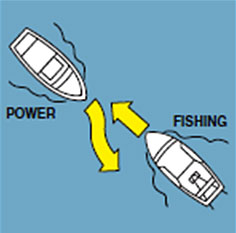
Rule 9 (c), however, stipulates that a vessel engaged in fishing cannot impede the navigation of a vessel on a narrow channel.
Narrow channel
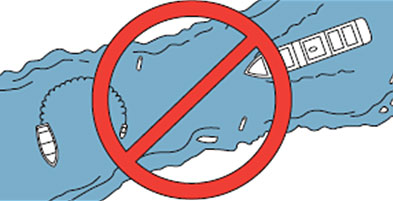
In addition, Rule 18 (a 3) stipulates that a power-driven vessel should keep out of the way of a vessel engaged in fishing.
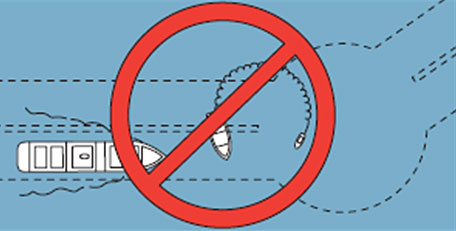
Section III – Conduct of vessels in restricted visibility
Rule 19
Conduct of vessels in restricted visibility
a) This Rule applies to vessels not in sight of one another when navigating in or near an area of restricted visibility.
b) Every vessel shall proceed at a safe speed adapted to the prevailing circumstances and conditions of restricted visibility. A power-driven vessel shall have her engines ready for immediate manoeuvre.
c) Every vessel shall have due regard to the prevailing circumstances and conditions of restricted visibility when complying with the Rules of Section I of this Part.
d) A vessel which detects by radar alone the presence of another vessel shall determine if a close-quarters situation is developing and/or risk of collision exists. If so, she shall take avoiding action in ample time, provided that when such action consists of an alteration of course, so far as possible the following shall be avoided:
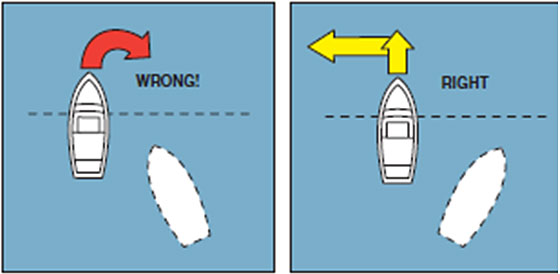
i) an alteration of course to port for a vessel forward of the beam, other than for a vessel being overtaken;
ii) an alteration of course towards a vessel abeam or abaft the beam.
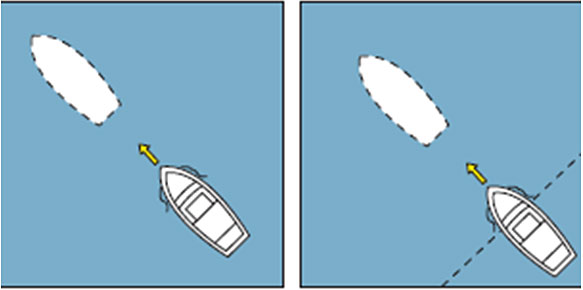
e) Except where it has been determined that a risk of collision does not exist, every vessel which hears apparently forward of her beam the fog signal of another vessel, or which cannot avoid a close-quarters situation with another vessel forward of her beam, shall reduce her speed to the minimum at which she can be kept on her course. She shall if necessary take all her way off and in any event navigate with extreme caution until danger of collision is over.
Explanations from the Centre for Lifelong Learning in the Westfjords:
Restricted visibility can issue from many reasons, such as fog, rain, snow, etc. In such circumstances the risk of collision is considerable.
If visibility is restricted we have to make use of the aids we have on board. If radar is on board we should use it, but we must also navigate with extreme carefulness and precision. Navigational lights should be immediately light up (in accordance with Rule 20) and sound signals should be given in accordance with Rule 35. This applies even though it is bright outside. The vessel should be navigated on suitable speed in accordance with circumstances. This is called to navigate on a “safe speed”, but it is not possible to say in advance what “safe speed” because it depends on the circumstances and must be evaluated in each case for itself.
“Safe speed” is subject to circumstances, such as whether there is any traffic on the area, how the weather is and the vessel’s manoeuvrability.
Smaller vessels take sharper turns and their stopping distance is shorter than larger vessels. This does not allow higher speed in restricted visibility.
If we are on the open sea or on a wide bay and without any notice pitch-black fog creeps in, it is good to stay put for awhile and listen for sound signals from other vessels. However, if we are on a narrow channel with heavy vessel traffic, it is not expedient to stay put.
When we stay put and listen for sound signals from other vessels, lighthouses or navigational aids we should never shut the engine down. It should always be running and ready to use on time.
